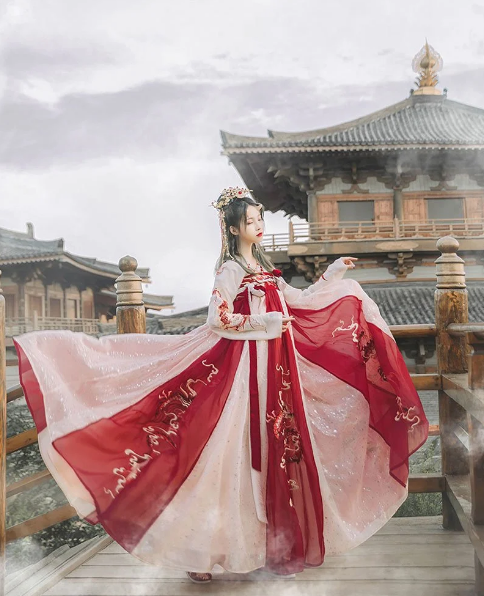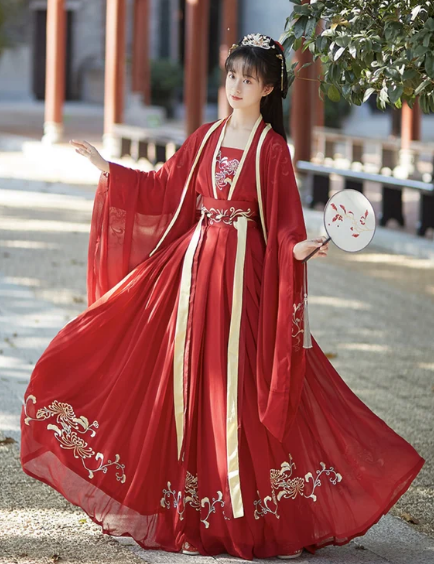Origins of Hanfu
Hanfu traces its roots to the earliest days of Chinese civilization, becoming a distinctive form of traditional clothing. It encapsulates the aesthetics and values of ancient Chinese society.
Historical Development
The creation of Hanfu sprung from the Han dynasty, symbolizing ethnic identity and social order. Silk, prized for its texture, often served as the primary material. Weavers and tailors paid immense attention to detail, reflecting the wearer’s social status. Throughout the dynasties, Hanfu evolved, incorporating diverse styles and ornaments. Every dynasty added its own touch to Hanfu, making the attire a tapestry of historical change.

Cultural Significance
This traditional attire carries deep cultural meanings, embodying the Confucian ideals of propriety and ritual. Hanfu is not just clothing; it’s a bridge to the past, revered during festivals and ceremonies. It represents a philosophy of living harmoniously with nature and society, showcasing the wearer’s cultural affinity. The Hanfu movement, a resurgence of interest in these traditional garments, highlights its enduring cultural significance.
The Components of Hanfu
The elegance of Hanfu comes from its unique components, each adding to its grace and complexity.
Traditional Garments and Layers
Hanfu typically involves several layers, starting with an inner garment or shirt known as “Zhongyi”. Over this, wearers add a “Yichang”, a long robe, and then a “Pao”, an overcoat. Each piece aligns with the body’s movement, offering comfort and dignity. Women often wear a “Ru”, a blouse, paired with a “Chang”, a pleated skirt. The number of layers can reflect the season, the wearer’s status, or the formality of an occasion.
Accessories and Embellishments
Accessories serve both function and adornment. Belts, often silk or leather, hold the Hanfu together and accentuate the silhouette. Jewelry, made from jade or gold, adds a layer of opulence and often denotes the wearer’s wealth. Embroideries on Hanfu, featuring dragons, phoenixes, or floral motifs, not only decorate but also convey messages of good fortune and status. Each stitch and embellishment on Hanfu requires meticulous handwork, displaying the wearer’s taste and the artisan’s skill.
Hanfu in Dynastic Eras
Hanfu not only has withstood the test of time but also adapted with each dynasty’s cultural ethos.
Variations Across Dynasties
The Shang dynasty favored deep-sleeved, loose robes tied with a sash. Han dynasty Hanfu showcased simplicity and elegance, with wide sleeves and a wrapped skirt. Tang dynasty attire became more elaborate, reflecting the empire’s wealth, with vibrant colors and luxurious fabrics like silk becoming the norm. The Song dynasty preferred straighter cuts and lighter garments. Each period introduced new elements, such as sleeve sizes or skirt lengths, showcasing the era’s aesthetic values and technological advancements.
Influences on Modern Designs
Modern fashion designers draw heavily from Hanfu’s rich tapestry of styles. They incorporate traditional motifs, such as dragon embroidery or cloud patterns, into contemporary clothing. The flow of the robes and the elegance of the layers find new expressions in modern dresses and formal wear. Traditional festivals and weddings often showcase these designs, blending ancient customs with modern tastes. This fusion ensures that Hanfu remains relevant and continues to inspire style across the globe.
Ceremonies and Traditional Events
Hanfu not only drapes the body but also graces the spirit of Chinese festivities and rites.
Hanfu in Weddings and Festivals
At weddings, the bride and groom often don traditional Hanfu, reflecting the solemnity and joy of the occasion. Red, symbolizing good luck and happiness, dominates the color scheme. During festivals like the Lunar New Year or the Mid-Autumn Festival, people don Hanfu to honor their heritage. Dragon Boat Festival and Qingming also see participants wearing Hanfu, engaging in age-old customs and celebrating the seasonal cycles.
Ritual Significance in Confucian Ceremonies
Confucian ceremonies, emphasizing order and hierarchy, often require participants to wear Hanfu. This attire signifies respect for tradition and the solemnity of the rituals. For instance, during the Confucian ceremony of ‘Coming of Age,’ young adults wear specific Hanfu styles to mark their transition into adulthood. Teachers’ Day and Confucius’ birthday celebrations often feature Hanfu, highlighting the ancient scholar’s lasting impact on Chinese culture.
The Hanfu Movement
The Hanfu movement captures a national renaissance of traditional Chinese clothing, celebrating cultural identity.
Revival in Contemporary China
Young people in China lead the charge, donning Hanfu not just for special occasions but also in daily life. Universities hold Hanfu-themed events, while cities host Hanfu parades, showcasing the beauty and diversity of these garments. This revival resonates with a growing desire to reconnect with China’s historical roots and express cultural pride.
Hanfu’s Influence on Pop Culture and Fashion
Hanfu has stepped onto the global stage, influencing pop culture and mainstream fashion. Film and television dramas set in historical periods showcase characters in intricate Hanfu, igniting viewer interest. Fashion designers incorporate Hanfu elements into modern clothing lines, blending traditional aesthetics with contemporary trends. Social media buzzes with Hanfu images, spreading its popularity among fashion enthusiasts worldwide.

Craftsmanship and Techniques
The art of making Hanfu showcases a fusion of ancient skills and artistic expression.
Fabric and Material Use
Silk, the hallmark of Chinese luxury, remains the preferred material for Hanfu due to its texture and sheen. Artisans also use cotton, linen, and wool, depending on the climate and the wearer’s status. Dyes come from natural sources: indigo for blues, madder for reds, and gardenia for yellows, ensuring the hues stay vibrant over time.
Sewing and Weaving Techniques
Artisans master complex sewing techniques, like the traditional ‘Luobian’ and ‘Dianbian’, which create durable seams. Weaving, especially on looms for silk, requires precision to maintain the fabric’s delicate patterns. Embroidery, another pivotal technique, involves intricate handwork, with stitches so fine they seem to blend seamlessly with the fabric.